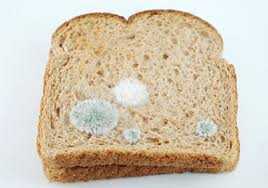Handling Food with Mold
Don’t Buy Moldy Foods
Examine food well before you buy it. Check food in glass jars, look at the stem areas on fresh produce, and avoid bruised produce. Notify the store manager about mold on foods! Be careful when handling food with mold.
Homemade Shelf-Stable Preserves Should be Water-Bath Processed
Yes, molds can thrive in high-acid foods like jams, jellies, pickles, fruit, and tomatoes. But these microscopic fungi are easily destroyed by heat processing high-acid foods at a temperature of 212 °F in a boiling water canner for the recommended length of time. For more information about processing home-canned foods, go to the National Center for Home Food Preservation at: www.uga.edu/nchfp/
Protect Food from Mold
- When serving food, keep it covered to prevent exposure to mold spores in the air. Use glass jars or glass bowls with glass covers (not plastic wrap) for foods you want to stay moist — fresh or cut fruits and vegetables, and green and mixed salads.
- Empty opened cans of perishable foods into clean glass storage containers and refrigerate them promptly. (Mold-Help recommends using frozen food. It is generally flash frozen and therefore preserved fresher. In addition, metal cans are usually lined with unhealthy chemicals.
- Don’t leave any perishables out of the refrigerator more than 2 hours.
- Use leftovers as soon as possible so mold doesn’t have a chance to grow. Do not keep more than 2 days.
Handling Food with Mold
Buying small amounts and using food quickly can help prevent mold growth. But when you see moldy food:
- Don’t sniff the moldy item. This can cause respiratory trouble.
- If food is covered with mold, discard it. Put it into a small paper bag or wrap it in plastic and dispose in a covered trash can that children and animals can’t get into.
- Clean the refrigerator or pantry with white cleaning vinegar at the spot where the food was stored.
- Check nearby items the moldy food might have touched. Mold spreads quickly in fruits and vegetables.
Moldy Food: When to Use, When to Discard
| FOOD | HANDLING | REASON |
| Luncheon meats, bacon, or hot dogs | Mold-Help does not recommend buying these foods. They can be contaminated during processing, and contain harmful chemicals. | Foods with high moisture content can be contaminated below the surface. Moldy foods may also have bacteria growing along with the mold. |
| Hard salami and dry-cured country hams | Mold-Help does not recommend buying these foods. They can be contaminated during processing, and contain harmful chemicals. | It is normal for these shelf-stable products to have surface mold. |
| Cooked leftover meat and poultry | Discard | Foods with high moisture content can be contaminated below the surface. Moldy foods may also have bacteria growing along with the mold. |
| Cooked casseroles | Discard | Foods with high moisture content can be contaminated below the surface. Moldy foods may also have bacteria growing along with the mold. |
| Cooked grain and pasta | Mold-Help does not recommend buying these foods. Grains are notorious for being contaminated with mold during storage and processing. They are also generally contaminated with pesticides, and most grains are grown from genetically modified seeds. | Foods with high moisture content can be contaminated below the surface. Moldy foods may also have bacteria growing along with the mold. |
| Hard cheese (not cheese where mold is part of the processing) |
Mold-Help does not recommend buying these foods. They can be contaminated during processing. | Mold can penetrate deep into the product. |
| Cheese made with mold (such as Roquefort, blue, Gorgonzola, Stilton, Brie, Camembert) |
Mold-Help does not recommend buying these foods. They are processed with mold. Discard soft cheeses such as Brie and Camembert if they contain molds that are not a part of the manufacturing process. | Molds that are not a part of the manufacturing process are be dangerous. |
| Soft cheese (such as cottage, cream cheese, Neufchatel, chevre, Bel Paese, etc.) Crumbled, shredded, and sliced cheeses (all types) |
Discard | Foods with high moisture content can be contaminated below the surface. Shredded, sliced, or crumbled cheese can be contaminated by the cutting instrument. Moldy soft cheese can also have bacteria growing along with the mold. |
| Yogurt and sour cream | Discard | Foods with high moisture content can be contaminated below the surface. Moldy foods may also have bacteria growing along with the mold. |
| Jams and jellies | Discard | The mold could be producing a mycotoxin. Microbiologists recommend against scooping out the mold and using the remaining condiment. |
| Fruits and vegetables, FIRM (such as cabbage, bell peppers, carrots, etc.) |
Use. Cut off at least 1 inch around and below the mold spot (keep the knife out of the mold itself so it will not cross-contaminate other parts of the produce). | Small mold spots can be cut off FIRM fruits and vegetables with low moisture content. |
| Fruits and vegetables, SOFT (such as cucumbers, peaches, tomatoes, etc.) |
Discard | SOFT fruits and vegetables with high moisture content can be contaminated below the surface. |
| Bread and baked goods | Discard | Porous foods can be contaminated below the surface. |
| Peanut butter, legumes and nuts | Discard | Foods processed without preservatives are at high risk for mold. |






